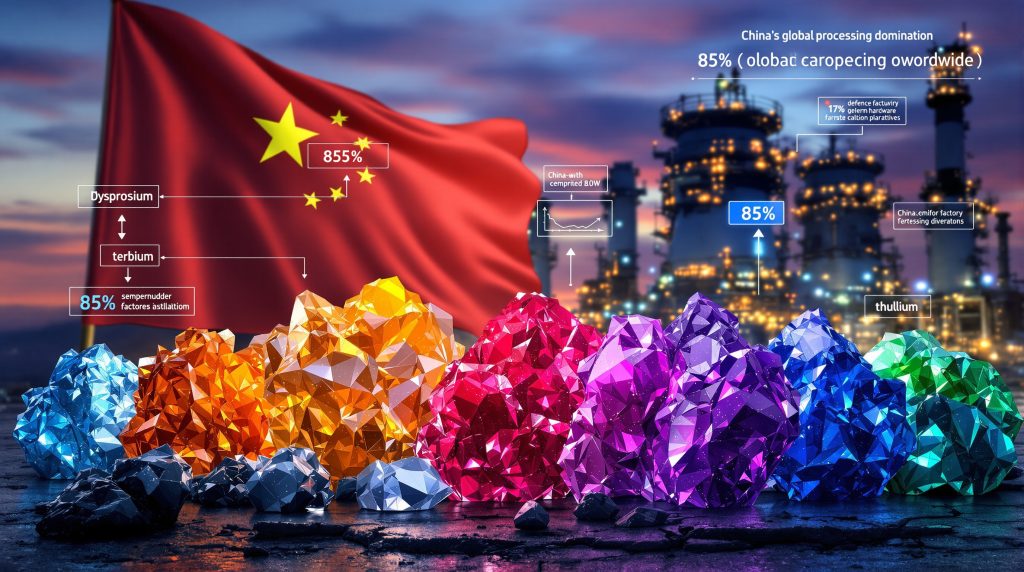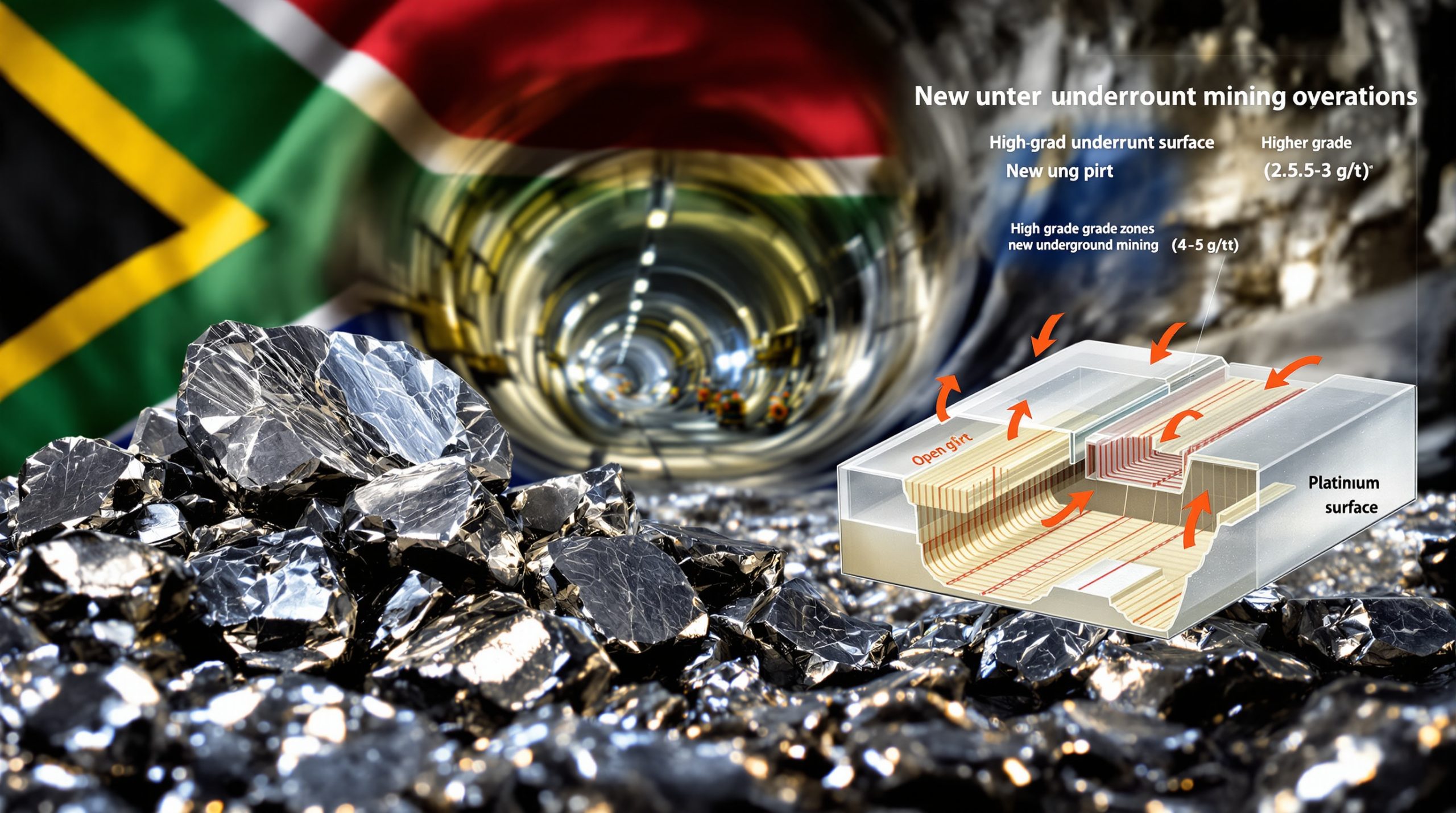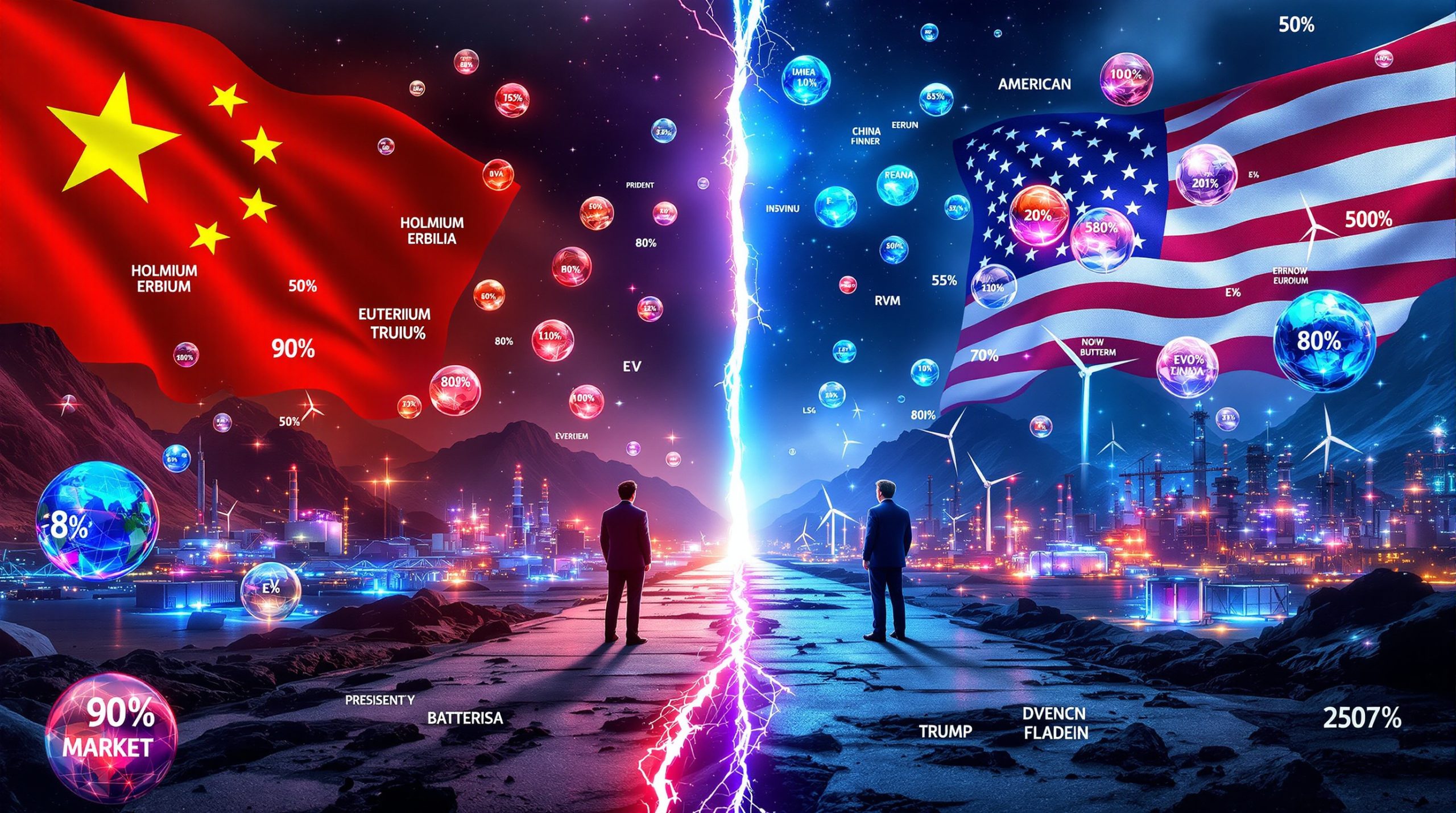China's Rare Earth Export Controls: Strategic Impacts on Global Technology and Defense Sectors
China has significantly broadened its rare earth export control regime through a series of strategic announcements made in October 2025. The expanded restrictions add five new rare earth elements to the controlled list, bringing the total to 12 restricted elements. These new controls specifically target foreign defense manufacturers and advanced semiconductor producers, marking a calculated escalation in China's use of its dominance in China rare earth export restrictions as a geopolitical tool.
New Elements Added to Export Control List
-
Previously restricted elements: Samarium, gadolinium, terbium, dysprosium, lutetium, scandium, and yttrium
-
Newly added elements: Holmium, erbium, thulium, europium, and ytterbium
-
Implementation timeline: New restrictions take effect November 8, 2025
-
Extended controls: Dozens of mining and refining equipment pieces also added to restriction list
Expanded Scope of Restrictions
-
Defense sector targeting: Export licenses will be denied to overseas defense manufacturers
-
Semiconductor industry focus: Applications for advanced semiconductor production evaluated case-by-case
-
Technology specificity: Controls target 14nm or more advanced chips, memory chips with 256+ layers
-
R&D limitations: Restrictions extend to research with potential military applications
Why Are Rare Earth Elements So Critical to Global Industries?
Rare earth elements constitute a group of 17 metals with unique magnetic, luminescent, and electrochemical properties that make them irreplaceable in numerous high-tech applications. Despite their name, most rare earths are relatively abundant in the Earth's crust, but economically viable concentrations are less common.
Essential Applications of Restricted Rare Earths
| Element | Key Applications | Industries Affected |
|---|---|---|
| Dysprosium | Permanent magnets, nuclear reactors | Defense, EVs, wind turbines |
| Terbium | Phosphors, magnets, solid-state devices | Electronics, medical imaging |
| Europium | Red/blue phosphors, nuclear control rods | Displays, lighting, nuclear |
| Erbium | Fiber optic amplifiers, lasers | Telecommunications, medical |
| Holmium | Strongest magnetic properties, lasers | Medical, nuclear, quantum computing |
| Ytterbium | Fiber optic technology, radiation monitoring | Communications, security |
| Thulium | Portable X-rays, lasers | Medical, military, metrology |
Critical Downstream Products at Risk
-
Neodymium-iron-boron magnets: Essential for electric vehicles, wind turbines, and hard disk drives
-
Precision-guided munitions: Rely on rare earth components for guidance systems
-
Advanced semiconductor manufacturing: Requires rare earth materials for polishing and doping
-
Fiber optic communications: Dependent on rare earth dopants for signal amplification
-
Medical imaging equipment: Uses rare earth phosphors and magnets
What Makes China's Dominance in Rare Earths So Significant?
China's commanding position in the rare earth supply chain gives it exceptional leverage in international trade and geopolitics. This dominance extends beyond raw material production to processing capabilities and manufacturing expertise.
China's Control Across the Rare Earth Value Chain
-
Raw material production: Approximately 60% of global mining output
-
Processing capacity: Over 85% of global rare earth separation and refining
-
Magnet manufacturing: Nearly 90% of global rare earth magnet production
-
Technology development: Thousands of rare earth-related patents filed annually
-
Domestic reserves: Estimated at 44 million tonnes, approximately 37% of global total
Strategic Integration of Rare Earth Industries
-
State coordination: China's rare earth industry operates under coordinated government oversight
-
Vertical integration: Chinese firms control multiple stages of the supply chain
-
Export quota history: Previous restrictions in 2010-2015 caused price spikes of up to 750%
-
Environmental advantage: Willingness to bear pollution costs that other nations avoid
-
Technology transfer requirements: Foreign companies often required to share technology for market access
How Will These Restrictions Impact Global Technology Supply Chains?
The expanded export controls create cascading effects throughout global technology supply chains, with particular significance for semiconductor manufacturing, defense contractors, and consumer electronics producers.
Immediate Market Consequences
-
Price volatility: Shares in major Chinese rare earth companies surged 9-10% following the announcement
-
Supply uncertainty: Even with licensing "facilitation measures," approvals remain unpredictable
-
Stockpiling behavior: Companies likely to increase inventory holdings despite higher carrying costs
-
Production delays: Manufacturing timelines extended due to material sourcing challenges
-
Regional disparities: Varying impacts based on diplomatic relations with China
Long-term Strategic Implications
-
Supply chain redesign: Companies accelerating efforts to develop alternative sources
-
Reshoring initiatives: Increased investment in domestic rare earth capabilities in US, EU, Australia
-
Substitution research: Intensified R&D to find alternative materials for critical applications
-
Recycling expansion: Greater focus on recovering rare earths from end-of-life products
-
Diplomatic realignment: Potential for new strategic partnerships around critical minerals
How Are Different Countries Responding to China's Rare Earth Strategy?
Nations are implementing varied strategies to address vulnerabilities exposed by China's rare earth export restrictions, with approaches tailored to their industrial needs and resource endowments.
United States Response
-
Defense Production Act: Invoked to support domestic rare earth production
-
Critical minerals list: Expanded to prioritize rare earth elements for strategic stockpiling
-
Research funding: Increased allocation for rare earth alternatives and processing technologies
-
Trade alliances: Strengthened partnerships with Australia, Canada, and other allies
-
Regulatory streamlining: Expedited permitting for new mining and processing facilities
European Union Initiatives
-
European Raw Materials Alliance: Expanded funding and scope to address rare earth vulnerabilities
-
Strategic autonomy framework: Rare earths designated as highest priority materials
-
Circular economy focus: Enhanced recycling programs for rare earth recovery
-
Greenland exploration: Accelerated development of Greenland critical minerals
-
Trade negotiations: Seeking dedicated rare earth supply agreements with non-Chinese producers
Asian Nations' Strategies
-
Japan: Expanded "urban mining" (recycling) programs and deep-sea exploration
-
South Korea: Assessing impact on semiconductor industry; seeking diplomatic solutions
-
India: Accelerating development of monazite sands containing rare earths
-
Vietnam: Increasing investment in rare earth separation capabilities
-
Malaysia: Reconsidering environmental restrictions on rare earth processing
What Are the Implications for Semiconductor and Defense Industries?
The targeted restrictions on defense and semiconductor applications represent a calculated escalation that directly impacts two strategically vital sectors with limited short-term alternatives.
Semiconductor Industry Vulnerabilities
-
Advanced node production: 14nm and below processes particularly affected
-
Memory chip manufacturing: 256+ layer NAND flash production faces material constraints
-
Equipment dependencies: Rare earths used in precision polishing and manufacturing tools
-
R&D limitations: Restrictions on research materials could slow innovation
-
Regional impacts: South Korean and Taiwanese manufacturers particularly exposed
Defense Sector Challenges
-
Precision guidance systems: Rely heavily on rare earth magnets and components
-
Radar and sonar technologies: Require specific rare earth elements for performance
-
Night vision equipment: Uses rare earth phosphors for image intensification
-
Communications systems: Dependent on rare earth components for miniaturization
-
Aircraft and naval propulsion: Advanced motors utilize rare earth magnets
What Alternatives Exist to Chinese Rare Earth Supplies?
While China's dominance remains unchallenged in the near term, several alternative sources and technological approaches are being developed to reduce dependency on Chinese rare earth supplies.
Emerging Mining Projects
-
MP Materials (USA): Expanding Mountain Pass mine with full supply chain integration
-
Lynas Rare Earths (Australia): Increasing production capacity at Mt. Weld
-
Iluka Resources (Australia): Developing rare earth refining capabilities
-
Rainbow Rare Earths (South Africa/Burundi): Advancing multiple African projects
-
Greenland Minerals: Progressing the Kvanefjeld project despite regulatory challenges
Technological Alternatives
-
Recycling innovations: New processes to recover rare earths from electronic waste
-
Synthetic substitutes: Development of alternative materials with similar properties
-
Design modifications: Engineering products to reduce or eliminate rare earth requirements
-
Urban mining: Systematic recovery from landfills and industrial waste
-
Deep-sea nodules: Exploration of ocean floor resources containing rare earths
How Does This Fit Into Broader US-China Trade Tensions?
China's expanded rare earth restrictions represent a calculated response to escalating US-China trade tensions, timed strategically ahead of diplomatic engagements between the two nations' leaders.
Recent Context of Trade Frictions
-
US semiconductor equipment bans: Lawmakers recently called for broader export restrictions
-
Tariff escalations: Ongoing increases in trade barriers between the countries
-
Technology decoupling: Accelerating separation of supply chains and technical standards
-
Investment restrictions: Mutual limitations on cross-border capital flows in strategic sectors
-
Diplomatic timing: Announcement precedes scheduled Trump-Xi meeting in South Korea
Strategic Negotiating Positions
-
Leverage building: Restrictions provide China with additional bargaining power
-
Proportional response: Measures calibrated to match perceived US aggression
-
Selective targeting: Focus on industries of particular strategic importance to US
-
Plausible deniability: Framed as legitimate national security and environmental measures
-
Diplomatic flexibility: "Facilitation measures" provide room for negotiated concessions
What Are the Long-term Implications for Global Resource Security?
China's rare earth restrictions highlight fundamental questions about resource nationalism, supply chain resilience, and the geopolitics of critical minerals that will shape international relations for decades to come.
Emerging Resource Security Paradigms
-
Strategic minerals doctrine: Nations increasingly viewing minerals through national security lens
-
Supply chain sovereignty: Movement toward self-sufficiency in critical resource processing
-
Resource diplomacy: Minerals becoming central to international alliance formation
-
Environmental-security balance: Tension between domestic environmental concerns and resource needs
-
Technology-resource nexus: Growing recognition of mineral foundations of technological leadership
Future Scenarios for Rare Earth Markets
-
Diversified supply: Multiple processing hubs develop outside China over 5-10 years
-
Technological leapfrogging: New technologies may reduce dependence on specific elements
-
Recycling revolution: Circular economy approaches could provide significant secondary supply
-
Continued Chinese dominance: Alternative sources may prove economically unviable
-
Resource conflict risks: Competition for limited supplies could exacerbate commodity market volatility
Frequently Asked Questions About Rare Earth Export Restrictions
What specific products will be most affected by these restrictions?
The restrictions will most significantly impact high-performance permanent magnets used in electric vehicle motors, wind turbine generators, and military guidance systems. Advanced semiconductor manufacturing equipment, particularly for 14nm and smaller nodes, will face material constraints. Other affected products include specialized lasers, fiber optic amplifiers, and high-precision optical components used in telecommunications and medical imaging.
How do these restrictions differ from China's previous rare earth controls?
The new restrictions expand beyond the original seven elements to include five additional rare earths, specifically targeting defense and semiconductor applications. They also introduce unprecedented extraterritorial application, requiring export licenses even for foreign manufacturers if they use Chinese equipment or materials in their production process. The previous restrictions focused primarily on raw materials, while these new controls extend to processing equipment and technology, as reported by Reuters.
Can other countries realistically replace China's rare earth production?
While several countries possess significant rare earth deposits, replacing China's processing capacity presents a greater challenge. Developing competitive separation and refining capabilities requires substantial capital investment, specialized expertise, and regulatory accommodations for environmental impacts. Complete supply chain replacement would likely take 5-10 years even with accelerated investment. However, targeted capacity for the most critical elements could be developed more quickly with sufficient political will and financial support as part of the broader energy transition in critical minerals.
What legal options do affected countries have under international trade law?
Countries may challenge China's restrictions through the World Trade Organization, arguing they violate non-discrimination principles and export restriction prohibitions. However, China can claim legitimate environmental protection and national security exemptions under WTO rules. The restrictions' design—as licensing requirements rather than outright bans—makes them more defensible under international trade law. Bilateral negotiations may prove more effective than formal WTO disputes, which can take years to resolve. In the United States, Trump's critical minerals order has already begun addressing supply chain vulnerabilities, according to The New York Times.
Disclaimer: This article contains forecasts and analyses of global rare earth markets and international trade relations. These predictions are based on current market conditions and geopolitical developments as of October 2025, but actual outcomes may differ significantly due to unforeseen political, economic, or technological developments. Readers should conduct their own research before making business or investment decisions related to rare earth elements or affected industries.
Looking for an Edge in Mining and Resource Investments?
Discover how to identify significant mineral discoveries before the market reacts with Discovery Alert's proprietary Discovery IQ model. Visit Discovery Alert's discoveries page to see how major mineral discoveries have historically delivered exceptional returns and start your 30-day free trial today.




